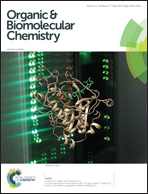Rational design of catalysts for asymmetric diamination reaction using transition state modeling†
Abstract
The stereoselective synthesis of 1,2-diamines has remained a formidable challenge. A recent palladium-catalyzed asymmetric diamination of conjugated double bonds using di-tert-butyldiaziridinone appears promising. The axially chiral binol phosphoramidite ligands are successful in offering high enantioselectivity. The density functional theory investigations revealed that the energies of the stereocontrolling transition states for the C–N bond formation depend on a number of weak non-covalent interactions such as C–H⋯π, C–H⋯O and anagostic interactions. We envisaged that the modulation in these interactions in the transition states, through subtle changes in chiral phosphoramidite substituents, could be exploited toward steering the stereoselectivity. The effect of systematic modifications on both 3,3′ positions of the binol as well as on the amido nitrogen on the stereochemical outcome is predicted. It is identified that high enantioselectivity requires a balance between the nature of the substituents on binol and amido groups. The reduced size of the amido substituents demands increased bulk on the binol whereas lowering the size on the binol demands increased bulk on the amido for higher stereoselectivity. The substituent at the α-position of the amido group is found to be vital and appears to be a hot spot for modifications. These insights derived from studies on the stereocontrolling transition states could help improve the catalytic efficacies in palladium-catalyzed asymmetric diamination reactions.


 Please wait while we load your content...
Please wait while we load your content...